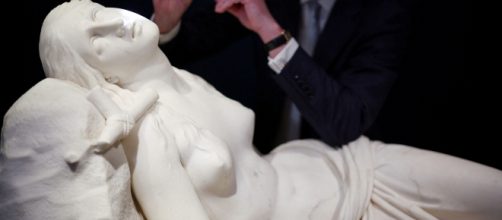At first, the story looked like your garden variety good news story about a long-lost treasure found, this time found not in an attic or basement but an auction sale as garden statuary.
The find: 18th-century sculptor Antonio Canova's carved marble figure "Recumbent Magdalene."
By all accounts, the art world sees this find as a huge deal. The Guardian calls it the "art world's sleeping beauty." The sculpture, expected to fetch up to $10 million, was mistakenly purchased as garden statuary.
I take issue with the way this sculpture is being promoted.
(More about this in a moment).
Taking exception
Christie's auction house will put the workup for sale in July. While CNN noted that it took Canova three years to carve the sculpture, finishing it just before he died in 1822, he made an astonishing comment.
This multinational news channel said Canova shows Magdalene "in a state of religious ecstasy." Have you seen this thing? What I see is a sprawled-out female with breasts wantonly exposed.
Instead of a state of "religious ecstasy" (or as The Guardian sees it, "a state of grief"), Magdalene looks to me to be sleeping off a state of erotic satisfaction.
Not that there haven't been images in art history showing Magdalene half nude. But they're usually titled Penitent Magdalene.
Titian's portrayal showing bared breasts comes to mind. But she is meant to look sorry, not sexually stupefied.
All that said, I don't take issue with the saint's state of undress in Canova's sculpture. The problem, as I see it, is that his Recumbent Magdalene looks too much like his sculpture "Venus Victrix" - Napoleon's bad-girl sister Pauline Bonaparte.
Given the resemblance between Canova's description of Magdalene in 1822 and Pauline in 1808, you might well call the newly found treasure Venus Victrix Sound Asleep.
Before and after
As one reclines seductively, and the other reclines surfeited, you get a kind of before and after effigy.
It looks like Christie's "International Head of Sculpture," Donald Johnston also saw the resemblance.
He told Reuters at a media preview, "For me facially, it's absolutely typical of Canova, but there are other signs." No kidding.
Johnston went on: "The way the feet are done, the way the hands are done, the way that the fingers have this sort of gentle curve..." is another way of saying that Magdalene looks like Pauline.
Are you getting this? While Magdalene was a follower of Christ and witnessed his Crucifixion, Pauline was so wayward that Napoleon exiled her to a Caribbean Island out of embarrassment.
Even so, Johnston told the press that the quality of Canva's Magdalene "sings out." It does, but not the way he means it. As auction houses sales need the highest dollar amount, it's not surprising that Johnston would pile on to the press.
He also said that Recumbent Magdalene "was one of the highlights of the Art Treasures Exhibition in Manchester in 1857." Of course, by then, Venus Victrix was about a half-century old. Likely exhibit goers forgot about the earlier work.
The sculpture will go on tour to New York and Hong Kong before it goes on the auction block. And the question remains: will anyone notice that Venus Victrix and Recumbent Magdalene look alike and shouldn't?


